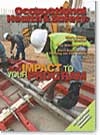
February 2004
Cover Story
By Diane McCrohan
THE hard hat has become the symbol of the construction industry. With this widely supported "branding" of construction as a safety-conscious industry came substantive reductions in injuries and illnesses--a 47 percent reduction, from 15.3 per hundred full-time construction workers in 1976 to 7.9 in 2001, according to the Bureau of Labor Statistics (BLS).
Features
By Marc Green, Ph.D.
IN theory, warnings are an important means for accident prevention. They reveal hidden hazards so the user of a product or facility can avoid injury. Unfortunately, warnings frequently, and some would say usually, fail to affect behavior.
By Valerie Weadock
WITH 12 seconds left in the fourth quarter, the Washington Redskins lead the Dallas Cowboys by four points. John, a 34-year-old construction worker, holds his breath as Cowboys quarterback Quincy Carter steps back and throws a deep pass to the end zone.
By Dian Cucchisi, Ph.D., CHMM
FOLLOWING Sept. 11, 2001 the question "How safe are we?" has entered our minds repeatedly. Previously, the idea of a potential terrorist attack included the use of weapons used in warfare or homemade bombs, such as in the first WTC attack.
By Bill Ramsey
LARGE industrial and stationary back-up batteries are used to "store" electrical power. The sudden and unplanned release of their direct current (DC) electricity can cause problems ranging from electric shock to battery fires or explosions.
By Robert Brown, CIH, CSP, CHMM
I have never actually entered a confined space, and to be honest, I have never really wanted to. I have, however, been responsible for ensuring the safe and effective entry into literally hundreds of confined spaces. One thing is for certain: The safest entry is no entry at all!
By Gerald Cordy
AS a facility safety director or fire protection manager, you have several types of training to offer to different groups of people.
THE industrial environment has changed substantially since OSHA first defined confined space entry (CSE) regulation in the late '70s, and gas detection regulation has not kept pace.
By Edwin Zalewski
YOU've conducted a hazard assessment, identified personal protective equipment requirements, and trained your employees, but they don't always wear their PPE. Sooner or later, their failure to use PPE will lead to an injury.
By Roger Brooks, Jr.
WHEN it comes to distractions, today's car and truck drivers can select any number of ways to focus on anything except the road. All of us know that jabbering on a cell phone or reading the newspaper while flying down the expressway during rush hour is probably not a good idea.
Departments
By Valerie Weadock
A small fire has broken out on the warehouse floor, and the scene is on the verge of total chaos. A few employees are searching desperately for the nearby fire extinguisher, while others run in fear of the spreading flames.
By Bruce T. Blythe, Teresa Butler Stivarius
THE setting may have been unusual, but the situation was familiar enough. A disgruntled former employee, whose lawsuit against a colleague had been thrown out of court, donned a bulletproof vest and helmet, armed himself with automatic weapons, and returned to terrorize the place where he once worked.